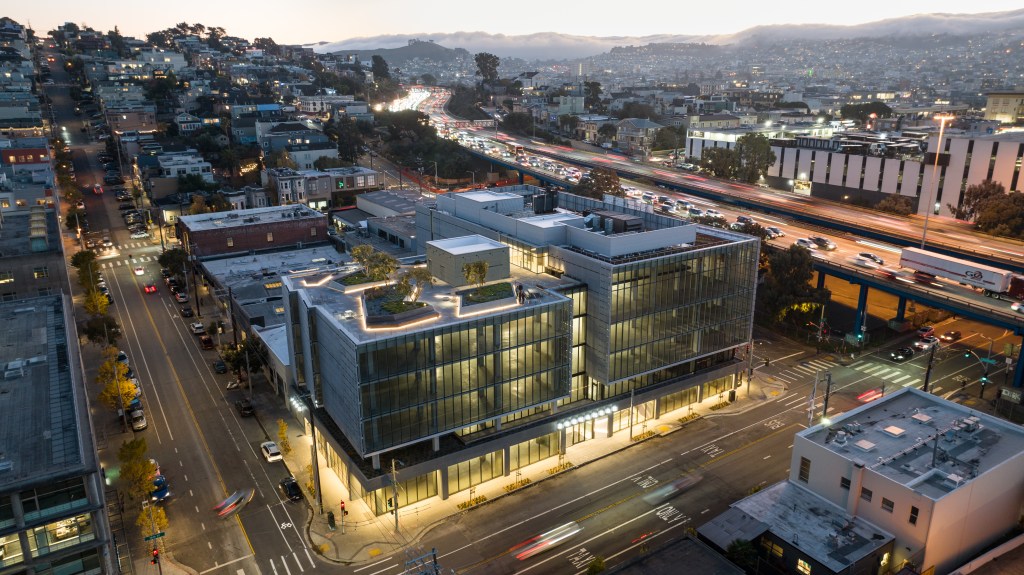AI Will Probably Boost Office Demand. And CRE at Large.
Dislocation is never easy, but there’s method to its madness—and opportunity.
You don’t have to search long for AI enthusiasts in commercial real estate, but then again, the skeptics are also around the corner. Sure, such emerging technologies might end up defining the whole century, but when it hits a lot closer to home, you do wonder. Will AI fill empty offices and other vacant commercial real estate space? Will it benefit the sector or simply change the paradigm so much, these questions won’t matter?
The possibility that AI could boost office space demand popped up more clearly last year, albeit at a local level. In 2023, San Francisco-based firms captured 67 percent of venture capital funding for global AI, and those in the Bay Area overall nabbed a whopping 78 percent.

In the City by the Bay alone, this translated into 1.1 million square feet of 2023 office leasing activity, according to Cushman & Wakefield research. Yes, yes, yes. While 1.1 million square feet is miniscule for a market of San Francisco’s size, an amplification in leasing last year could be a harbinger of things to come. If AI grows and evolves, so will the system supporting it.
READ ALSO: Where to Find the Bright Side of Office
Ermengarde Jabir, senior economist at Moody’s, believes AI will drive office demand. “Many perhaps fail to realize in their alarmism over AI taking everyone’s jobs, that to build and maintain AI requires a large workforce,” she said. “While certain types of jobs may become obsolete because of AI, other sets of skills will become prevalent, and very in demand in order to keep AI operational.”
Face to face
Today’s AI firms have determined, almost universally, that the work they conduct is best undertaken in offices, said Ethan McCall, vice-president of Spear Street Capital, developer of the new 300 Kansas building in San Francisco’s Potrero Hill. The property was developed to enable firms to recruit and retain the city’s finest AI talent and build market-leading firms, he said.
Echoing the notion that AI companies undertake ideation and development work within offices is Katy Redmond, technology industry lead, markets advisory at JLL. Working within shared physical space is integral to the establishment of teams and in-person collaboration required to move AI forward, she said.
She and her colleagues understand that dynamic because of the way their clients in the AI space describe their workplace needs. That’s why she’s more optimistic about footprint growth for AI firms vis-a-vis other types of tenants.
Already, AI organizations are involved in a flight to higher-quality spaces in their push to invest in tech-enabled square footage. A number have recently garnered venture capital funding and now require additional space for growing staffs, Redmond pointed out.
READ ALSO: Cause for Optimism on the Tech Front
“Some of the companies have grown so quickly that within a few months they are out looking for more space,” she added. “We’ve also seen greater emphasis among major retail, financial and legal companies on AI divisions, (resulting) in greater space needs among some of these companies.”
In addition to AI companies, JLL has also tracked footprint growth of app and developer tool companies built on top of the main AI models, and expansions of AI teams in industries like health care and life sciences, Redmond reported.
She envisions the Bay Area remaining the nexus for AI companies over the next 5 years. But as generative AI becomes established, she foresees more growth in leading markets such as Boston, New York and Seattle. With AI a major focus of government and defense contractors, the Washington, D.C., area should also benefit.
Redmond also predicted growth in AI will in turn propel additional advancement in supporting industries.
Data centers, semiconductor manufacturers, AI application companies and others are anticipated to flourish, leading to footprint expansion of the supporting infrastructure required, she concluded.
Blast radius
A similar sentiment comes from Charles Clinton, CEO & co-founder of real estate investing platform Equity Multiple, who believes a multiplier effect may result from investment in firms the likes of OpenAI and Anthropic.
“These firms will create a blast radius of demand in real estate markets,” he reasoned. “Smaller firms will pop up to benefit from the talent that the larger firms draw and to create ancillary value-add services on top of the fundamental AI progress delivered by larger firms. An influx of highly compensated employees will create demand for coworking space, coffee shops and yoga studios, creating demand for flex office space, retail, mixed-use space as well as multifamily. We saw the same thing happen with Microsoft’s impact on the Greater Seattle area, and Google’s impact on Silicon Valley and the South Bay.”
READ ALSO: 7 Uses for AI in CRE
Clinton and his colleagues also believe the adoption of AI will propel a trend toward creation of satellite offices and flex collaborative spaces in non-central business districts, such as suburbs and outlying urban neighborhoods inside the borders of major cities.
Don’t bet on AI’s space needs being limited solely to urban and suburban areas, added David Dowell, partner of architectural firm El Dorado. The company, which teamed with Spear Street Capital on 300 Kansas, handles work in rural Tennessee and rural Kansas. There, “satellite-based connectivity has been a game changer,” Dowell said. “This may surprise people, but cities are not the only place where digital innovation is and will continue to occur. There are completely different design considerations and opportunities for rural places.”
Regardless of setting, AI firms’ needs may veer toward spaces more closely resembling light industrial or manufacturing than traditional office footprints, Dowell said. They need large facilities with workspace, collaboration zones and employee amenities, as well as floor area for computers and servers linked to significant building system capacity, including electrical and ventilation.
Growth phase
Taking a distinctly more cautious view is Lucas Bianchi, founder & CEO of Namaste Credit, an online marketplace for lenders, SMEs and loan agents, headquartered in India. Substantial gains in office space demand from AI companies should be expected only as the firms mature and evolve toward later funding stages, Series B, C and beyond, he said. This expansion phase often requires sizable investments and significant job growth.
The substantial 2023 San Francisco office space absorption authored by AI companies like OpenAI, Databricks and Anthropic remains but a fraction of the city’s 86 million square feet of office, approximately 30 percent of it empty. AI will benefit San Francisco initially, but due to the technology’s Bay Area focus, other cities aren’t likely to be advantaged for some time, Bianchi said.
AI firms’ unique needs, which may include special hardware, space for robotic testing and areas for creative brainstorming, may provide a “localized boom” in Bay Area office space demand for 5 or 10 years. “That said, it is not yet clear whether, over time, AI companies will require more or less space per employee or per company,” he said.
“In other cities, the effect may be less pronounced and slower to materialize, due to differing rates of AI adoption and the potential for AI to reduce traditional office needs through automation and remote work enhancements.”
Decade out
While few are willing to attempt even hazy predictions regarding where AI will lead the CRE market years from now, Redmond did observe, “Ten years from now is the really exciting part… We don’t know for certain where AI will be in 10 years, but PwC and McKinsey forecast AI to be major contributors to global GDP by then. If this scenario plays out, the supporting infrastructure required for app-based companies means AI will be firmly entrenched in commercial real estate, becoming major occupiers not just in the Bay Area but in secondary and tertiary markets as well.”
Compared to what’s predicted for AI’s future, the current status of the industry might be best described as embryonic. This may explain AI companies’ tentativeness about inking big leases, despite headcount and investment growth, Clinton said.
To get a handle on where the technology may be 10 years from now, it’s necessary to think beyond AI companies themselves, he added. That’s because AI use cases could accelerate productivity gains in sectors as widely diverse as health care, the law, data-heavy fields such as accounting and consulting and novel applications not yet imagined.
“With past major innovations, like internal combustion engines and personal computers, it took decades for the technology to really propagate through the economy,” Clinton said.
“It could well be different with AI because of the accessibility of the technology and because it is growing in power exponentially. The hope is that this will create new entrepreneurship and productivity gains across a wide range of industries and a wide range of markets. Office investment may or may not concentrate around central business districts. But an AI-driven revolution will broadly benefit the office sector, as well as many other commercial real estate property types.”







You must be logged in to post a comment.